COMMENT OF THE DAY: WHAT LIFE FORMS HOMES GOT RIGHT 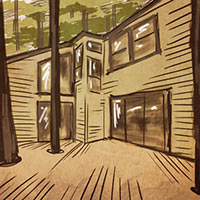 “I’m also a big Life Forms fan, I own and live in one in the Woodlands. So happens I’m an architect, too. Life Forms is the only company I know that has built suburban tract homes which are innovative, spatially unique, extremely livable, and which complement the landscape. Truly American, as I would like to say it. Many of Life Forms homes were also created for a price point that allowed normal folks like us to experience unique and honest architecture. I do that every day now. Scott Mitchell deserves unique credit as an exceptional architect, a brilliant home builder, and a true innovator.
Most American architecture amounts to mindlessly recompiled ‘tradition,’ endlessly mundane and pretentious. No where is this more evident than in American tract homes. Bad copies of architectural forms and inspiration: selectively applied pastiche . . . that is the norm. As the ‘home of the free and the brave,’ as social and technological pioneers, we Americans ought to pride ourselves on our residential buildings, too. Life Forms challenged the organization, layout, forms, spaces, use of light . . . just about everything that’s bad about the typical american home. Sure some of the details may look dated to us now, and not all the experiments they did were successful. But many of them were. . . .” [Paul Schuyler, commenting on A Look at George Mitchell’s Decked-Out Home in The Woodlands, All Cleaned Up and Cleared Out for Sale] Illustration: Lulu
“I’m also a big Life Forms fan, I own and live in one in the Woodlands. So happens I’m an architect, too. Life Forms is the only company I know that has built suburban tract homes which are innovative, spatially unique, extremely livable, and which complement the landscape. Truly American, as I would like to say it. Many of Life Forms homes were also created for a price point that allowed normal folks like us to experience unique and honest architecture. I do that every day now. Scott Mitchell deserves unique credit as an exceptional architect, a brilliant home builder, and a true innovator.
Most American architecture amounts to mindlessly recompiled ‘tradition,’ endlessly mundane and pretentious. No where is this more evident than in American tract homes. Bad copies of architectural forms and inspiration: selectively applied pastiche . . . that is the norm. As the ‘home of the free and the brave,’ as social and technological pioneers, we Americans ought to pride ourselves on our residential buildings, too. Life Forms challenged the organization, layout, forms, spaces, use of light . . . just about everything that’s bad about the typical american home. Sure some of the details may look dated to us now, and not all the experiments they did were successful. But many of them were. . . .” [Paul Schuyler, commenting on A Look at George Mitchell’s Decked-Out Home in The Woodlands, All Cleaned Up and Cleared Out for Sale] Illustration: Lulu
Quicklink
COMMENT OF THE DAY: HOUSTON REAL ESTATE PROBLEMS, WITH OR WITHOUT CHEAP OIL  “The Houston market had a few easily identifiable problems even before the drop in oil prices.
1) Older homeowners with paid off or mostly paid off homes are asking unrealistically high prices for fixer uppers or tear downs. That’s slowing down new home purchases and new builds. That was a problem at $100 oil. Well priced homes moved and unrealistically high priced homes sat. People wanting $300K for a total fixer upper inside Beltway 8 or $400K for a lot near the 610 loop are just completely slowing down the revitalization process as those houses/lots sit for months on end while everyone thinks the sky is falling.
2) Near loop new construction is priced exclusively for people making $200K and up. A family of two earners making $50K (teachers, cops, firefighters, non O&G professionals) can only afford to live out west in the burbs, but many are choosing to rent rather than go west. There’s no attempt at affordable housing inside the beltway. When oil goes down, the engineers stop buying in Houston. The aforementioned buyers would be happy with smaller houses they could afford to get into but the developers are chasing the biggest gains possible on each new build.
The real estate market will ultimately be fine for people who didn’t overpay but it would be nice to see changes that reflect reality now that oil is not at $100.” [Houstonian, commenting on Tanking Oil Prices Place Houston Second on Fitch’s Overvalued Housing Market List] Illustration: Lulu
“The Houston market had a few easily identifiable problems even before the drop in oil prices.
1) Older homeowners with paid off or mostly paid off homes are asking unrealistically high prices for fixer uppers or tear downs. That’s slowing down new home purchases and new builds. That was a problem at $100 oil. Well priced homes moved and unrealistically high priced homes sat. People wanting $300K for a total fixer upper inside Beltway 8 or $400K for a lot near the 610 loop are just completely slowing down the revitalization process as those houses/lots sit for months on end while everyone thinks the sky is falling.
2) Near loop new construction is priced exclusively for people making $200K and up. A family of two earners making $50K (teachers, cops, firefighters, non O&G professionals) can only afford to live out west in the burbs, but many are choosing to rent rather than go west. There’s no attempt at affordable housing inside the beltway. When oil goes down, the engineers stop buying in Houston. The aforementioned buyers would be happy with smaller houses they could afford to get into but the developers are chasing the biggest gains possible on each new build.
The real estate market will ultimately be fine for people who didn’t overpay but it would be nice to see changes that reflect reality now that oil is not at $100.” [Houstonian, commenting on Tanking Oil Prices Place Houston Second on Fitch’s Overvalued Housing Market List] Illustration: Lulu
UP IN THE AIR AND ROTATING AT THE CORNER OF MONTROSE AND HAWTHORNE 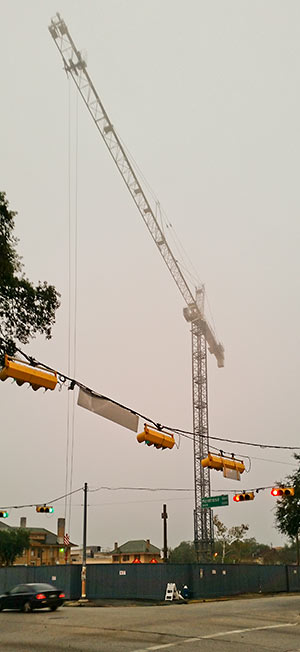 Here’s your photo proof that the construction crane for Hanover’s new 30-story 3400 Montrose apartment building going up at 3400 Montrose Blvd., on the site of the 3400 Montrose office building torn down earlier this year, went up before Christmas 2014. A reader sends in this shot from the catty-corner corner at cross street Hawthorne. The crane was assembled on site last week. [Previously on Swamplot] Photo: Swamplot inbox
Here’s your photo proof that the construction crane for Hanover’s new 30-story 3400 Montrose apartment building going up at 3400 Montrose Blvd., on the site of the 3400 Montrose office building torn down earlier this year, went up before Christmas 2014. A reader sends in this shot from the catty-corner corner at cross street Hawthorne. The crane was assembled on site last week. [Previously on Swamplot] Photo: Swamplot inbox
TANKING OIL PRICES PLACE HOUSTON SECOND ON FITCH’S OVERVALUED HOUSING MARKET LIST  With homes selling on average 19 percent above their value, Houston trails only Austin as an overheated U.S. market, says mortgage securities group Fitch Ratings. “What we’re most worried about is speculative buying and selling,” says Fitch analyst Stefan Hilts. “People aren’t buying houses because they need to; it’s because they can. That’s causing a big market distortion.” Sub-$60 oil gets much of the blame, but there are several other factors at play: student debt, rising home prices, the tendency of the millennial generation to delay home ownership, and high apartment rents hampering the ability of would-be homeowners to save for a down payment. [Houston Business Journal] Photo of Gary Sweeney sign at Art Guys World Headquarters: Shawna Mouser
With homes selling on average 19 percent above their value, Houston trails only Austin as an overheated U.S. market, says mortgage securities group Fitch Ratings. “What we’re most worried about is speculative buying and selling,” says Fitch analyst Stefan Hilts. “People aren’t buying houses because they need to; it’s because they can. That’s causing a big market distortion.” Sub-$60 oil gets much of the blame, but there are several other factors at play: student debt, rising home prices, the tendency of the millennial generation to delay home ownership, and high apartment rents hampering the ability of would-be homeowners to save for a down payment. [Houston Business Journal] Photo of Gary Sweeney sign at Art Guys World Headquarters: Shawna Mouser
END OF YEAR MONTROSE HOME CLEARANCE 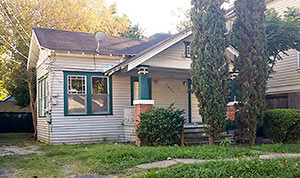 Looking for that last-minute, low-cost, blockbuster Christmas gift for a certain someone who has . . . a place to put anything? Over on Craigslist, someone is offering this well-worn, 2-bedroom, 2-bath 1925 bungalow in Hyde Park for the gotta-grab-it-now price of free. What’s the catch? Just explain it to the gift recipient as a New Year’s resolution: The home must be removed from its lot at 1225 Welch St. by January 15th. (Which will certainly end up costing a fair bit more than free.) Meanwhile, the same home is still listed for sale on MLSÂ — with its 5,000-sq.-ft. lot — for a somewhat higher price: $525,000. [Craigslist; HAR]
Looking for that last-minute, low-cost, blockbuster Christmas gift for a certain someone who has . . . a place to put anything? Over on Craigslist, someone is offering this well-worn, 2-bedroom, 2-bath 1925 bungalow in Hyde Park for the gotta-grab-it-now price of free. What’s the catch? Just explain it to the gift recipient as a New Year’s resolution: The home must be removed from its lot at 1225 Welch St. by January 15th. (Which will certainly end up costing a fair bit more than free.) Meanwhile, the same home is still listed for sale on MLSÂ — with its 5,000-sq.-ft. lot — for a somewhat higher price: $525,000. [Craigslist; HAR]
OH MY GOD! THEY KILLED KYLE! Here’s a view from the front row yesterday morning as the west side of Kyle Field comes a’-tumbling down, to the cheers, hullabaloo, and whoops of a crowd police estimated at 7,000. The Aggies are eager for the final phase of the school’s ongoing stadium renovation project to come to completion. After hauling off the 75,000 tons of debris, and rebuilding, the Aggies plan to have Kyle Field reopened — with a capacity of 102,51, the largest stadium in Texas — by September 12, when Ball State University’s gridiron warriors invade College Station in new Kyle Field’s debut. [Bryan-College Station Eagle; previously on Swamplot] Video: Ton Wagner
COMMENT OF THE DAY: WHY IS ANYONE LIVING THAT CLOSE TO A REFINERY?  “Tax policy should probably discourage residential habitation in neighborhoods near the Houston Ship Channel and encourage people to move away from them. As such, giving existing residents or residential property owners a tax cut in order to reward them for residing there or maintaining and leasing housing to other people would be extraordinarily counterproductive and stupid.
Manchester in particular is a neighborhood where the City or State government should seriously consider its options with respect to eminent domain. There’s nothing quite like it anywhere else in the region. Even the furthest north residential bits and pieces of Pasadena are better isolated from refinery activities and more integrated into their city than is Manchester.” [TheNiche, commenting on Baytown Buc-ee’s Is Here; Goodbye Mission Burrito, Hello Ãœberrito Mexican Grill] Illustration: Lulu
“Tax policy should probably discourage residential habitation in neighborhoods near the Houston Ship Channel and encourage people to move away from them. As such, giving existing residents or residential property owners a tax cut in order to reward them for residing there or maintaining and leasing housing to other people would be extraordinarily counterproductive and stupid.
Manchester in particular is a neighborhood where the City or State government should seriously consider its options with respect to eminent domain. There’s nothing quite like it anywhere else in the region. Even the furthest north residential bits and pieces of Pasadena are better isolated from refinery activities and more integrated into their city than is Manchester.” [TheNiche, commenting on Baytown Buc-ee’s Is Here; Goodbye Mission Burrito, Hello Ãœberrito Mexican Grill] Illustration: Lulu
WHICH A&M BUILDING HAS GOVERNOR PERRY’S NAME ON IT NOW?  Two days of “deep reflection” after telling the Bryan-College Station Eagle that he would be honored to have Texas A&M’s iconic Academic Building renamed “The Rick Perry ’72 Building,” Governor Rick Perry decided to decline the proposal by the A&M Board of Regents before it ever came to a vote. “I have informed the board of regents of my decision to politely decline this honor,” Perry said at a graduation ceremony last night, hours after the vote was supposed to have taken place. “And I do so because there are places on this campus, like our most cherished traditions, that transcend any one individual. They are bigger than any one of us and they represent our shared heritage. I want the Academic Building to be called the Academic Building in 2114, 200 years after it was built.” Perry’s announcement came after 2 days of intense, mostly negative reaction to news of the proposal, including a resolution against the renaming from the student senate, a petition signed by 7,000 students in opposition to same, and an editorial in The Battalion, A&M’s campus paper, which reads, in part: “The absurdity of the idea goes well beyond the irony of putting Perry (and his well-documented sub-2.5 GPA) on A&M’s academic hub, which in 2014 celebrates its 100th birthday. The regents shouldn’t name the Academic Building after the governor. Not because he’s not qualified, but because no one is.” Which is not to say that some other campus edifice might not soon bear the Perry name, as the editorial acknowledges: “Perry might deserve campus recognition, but give him something — anything — other than the Academic Building.” [Bryan-College Station Eagle; The Battalion] Photo: Texas A&M
Two days of “deep reflection” after telling the Bryan-College Station Eagle that he would be honored to have Texas A&M’s iconic Academic Building renamed “The Rick Perry ’72 Building,” Governor Rick Perry decided to decline the proposal by the A&M Board of Regents before it ever came to a vote. “I have informed the board of regents of my decision to politely decline this honor,” Perry said at a graduation ceremony last night, hours after the vote was supposed to have taken place. “And I do so because there are places on this campus, like our most cherished traditions, that transcend any one individual. They are bigger than any one of us and they represent our shared heritage. I want the Academic Building to be called the Academic Building in 2114, 200 years after it was built.” Perry’s announcement came after 2 days of intense, mostly negative reaction to news of the proposal, including a resolution against the renaming from the student senate, a petition signed by 7,000 students in opposition to same, and an editorial in The Battalion, A&M’s campus paper, which reads, in part: “The absurdity of the idea goes well beyond the irony of putting Perry (and his well-documented sub-2.5 GPA) on A&M’s academic hub, which in 2014 celebrates its 100th birthday. The regents shouldn’t name the Academic Building after the governor. Not because he’s not qualified, but because no one is.” Which is not to say that some other campus edifice might not soon bear the Perry name, as the editorial acknowledges: “Perry might deserve campus recognition, but give him something — anything — other than the Academic Building.” [Bryan-College Station Eagle; The Battalion] Photo: Texas A&M
BIG NEWS ON WASHINGTON AVE  Update, 12/19/2016: A representative from Midway tells Swamplot that Midway didn’t buy the complex — it’s just been managing it for the folks who did (the Gordy family). This article has been updated. Archstone Memorial Heights, that 556-unit apartment complex at 201 S. Heights on 23.4 acres of Washington Corridor land (seen here pre-renovation 2 years ago), has been sold. The buyers?
Update, 12/19/2016: A representative from Midway tells Swamplot that Midway didn’t buy the complex — it’s just been managing it for the folks who did (the Gordy family). This article has been updated. Archstone Memorial Heights, that 556-unit apartment complex at 201 S. Heights on 23.4 acres of Washington Corridor land (seen here pre-renovation 2 years ago), has been sold. The buyers? Midway Cos. and the Lionstone Group. Midway is perhaps best-known locally for its mixed-used CityCentre development and the Hotel Sorella. [RE Business Online] Photo: Charles Kuffner
BEN KOUSH: ADDING A 4-STORY ‘GAS TANK’ TO THE ALLEY’S ROOF NOT MY IDEA OF PRESERVATION 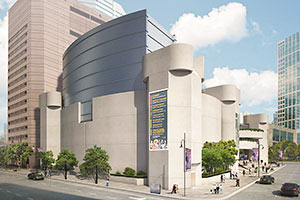 Citing it as epitomizing Houston’s ineptitude in historic preservation, architect and former Houston Mod president Ben Koush soundly lambasted a May rendering of the Alley Theatre’s ongoing renovation by Studio Red, of Summit-into-Lakewood transformation fame. Koush saves most of his bile for the planned gridded fly-loft rising 4-stories above the theater’s roofline. “The original building evoked a castle,” Koush writes. “In the drawing, the new fly loft looks looks like a gas tank or grain storage bin dropped atop that castle. One can only wonder why Studio Red’s insistent design was not more restrained.†Studio Red has since pulled the rendering from its website, calling it “a terrible fisheye view of the fly loft that completely distorts what it will look like.” Distorted or not, the fly loft’s metallic appearance will contrast with Ulrich Franzen’s Brutalist concrete design, and Koush contends that such an essential alteration of the Alley is not the sort of project that groups like Houston Mod and the Texas Society of Architects should be lauding. [Gray Matters; previously on Swamplot] Photo: The Architect’s Newspaper.
Citing it as epitomizing Houston’s ineptitude in historic preservation, architect and former Houston Mod president Ben Koush soundly lambasted a May rendering of the Alley Theatre’s ongoing renovation by Studio Red, of Summit-into-Lakewood transformation fame. Koush saves most of his bile for the planned gridded fly-loft rising 4-stories above the theater’s roofline. “The original building evoked a castle,” Koush writes. “In the drawing, the new fly loft looks looks like a gas tank or grain storage bin dropped atop that castle. One can only wonder why Studio Red’s insistent design was not more restrained.†Studio Red has since pulled the rendering from its website, calling it “a terrible fisheye view of the fly loft that completely distorts what it will look like.” Distorted or not, the fly loft’s metallic appearance will contrast with Ulrich Franzen’s Brutalist concrete design, and Koush contends that such an essential alteration of the Alley is not the sort of project that groups like Houston Mod and the Texas Society of Architects should be lauding. [Gray Matters; previously on Swamplot] Photo: The Architect’s Newspaper.
THE SPJST IS NOT CZECHING OUT OF SHADY ACRES, ACCORDING TO LODGE CHAIRMAN  Talk of an upcoming sale of the SPJST Lodge #88 is no more than just talk, according to the lodge’s chairman of the board Mildred Holeman. “The consensus has been that it will not be sold at any price,†she tells the Houston Chronicle‘s Craig Hlavaty, referring to an ongoing mail-in election to decide whether or not the Czech heritage fraternal organization, dance hall, party venue and once-a-week bingo parlor will remain on the 9-acre Shady Acres site at 1435 Beall St. it will have occupied for 50 years next year. Holeman, 88 and a real estate agent, also dishes details on the property’s suitors: townhome developers who have offered the organization $10 million. Long-term lodge member Lindsey Michalak-Kindall did not share Holeman’s assurance of a secure future for the lodge. She tells Hlavaty that the explanation letter and ballot went out too late for members to learn of the one and only meeting to discuss the possible sale — last weekend, only a day or two after most members received the letter and ballot. She also characterized the letter as “doom and gloom” and blase about what would happen to the lodge if the property was sold. All ballots must be in the organization’s Temple, Texas head office by December 31, with an announcement of the election’s result coming at January’s Houston membership meeting. [Houston Chronicle, previously on Swamplot] Photo: Swamplot inbox.)
Talk of an upcoming sale of the SPJST Lodge #88 is no more than just talk, according to the lodge’s chairman of the board Mildred Holeman. “The consensus has been that it will not be sold at any price,†she tells the Houston Chronicle‘s Craig Hlavaty, referring to an ongoing mail-in election to decide whether or not the Czech heritage fraternal organization, dance hall, party venue and once-a-week bingo parlor will remain on the 9-acre Shady Acres site at 1435 Beall St. it will have occupied for 50 years next year. Holeman, 88 and a real estate agent, also dishes details on the property’s suitors: townhome developers who have offered the organization $10 million. Long-term lodge member Lindsey Michalak-Kindall did not share Holeman’s assurance of a secure future for the lodge. She tells Hlavaty that the explanation letter and ballot went out too late for members to learn of the one and only meeting to discuss the possible sale — last weekend, only a day or two after most members received the letter and ballot. She also characterized the letter as “doom and gloom” and blase about what would happen to the lodge if the property was sold. All ballots must be in the organization’s Temple, Texas head office by December 31, with an announcement of the election’s result coming at January’s Houston membership meeting. [Houston Chronicle, previously on Swamplot] Photo: Swamplot inbox.)
COMMENT OF THE DAY: BOSTON. IT’S WORTH IT TOO.  “I live in Boston which is pretty much the anti-Houston, moving there as an adult fleeing some of the things Blue Dog celebrates. Born and raised in sprawling Omaha, Nebraska, with its struggling downtown and leapfrogging subdivisions, I came east seeking the density, the option of subways and streetcars and walking because of the relative proximity of destinations, the historic architecture of row houses and institutions, the amenities of a major gateway city with an urban vibe. You’d hate Boston, the high cost of living, the terrible traffic on our chaotic layout of colliding streets, the lack of space, and the cold winters. I don’t like those things either, but I’ve decided to live with them because of the things I do like. You’ve made your choice too, and you intelligently don’t deny that you live in flat, sprawling, hot-humid, ten-lane-wide highway beribboned mass of strip mall scattered anonymity because you like it. And no snobby eastern elitist transplant so blinkered, he can’t appreciate the collective expression of American freedom that is Post Oak or The Woodlands or Sugarland or cul-de-sac-paradise-of-your-choice will . . . convince you otherwise. Midtown does seem to me kind of nice though :-)” [Robert H, commenting on Comment of the Day: The Real Houston Is Outside Those Tiny Urban Islands] Illustration: Lulu
“I live in Boston which is pretty much the anti-Houston, moving there as an adult fleeing some of the things Blue Dog celebrates. Born and raised in sprawling Omaha, Nebraska, with its struggling downtown and leapfrogging subdivisions, I came east seeking the density, the option of subways and streetcars and walking because of the relative proximity of destinations, the historic architecture of row houses and institutions, the amenities of a major gateway city with an urban vibe. You’d hate Boston, the high cost of living, the terrible traffic on our chaotic layout of colliding streets, the lack of space, and the cold winters. I don’t like those things either, but I’ve decided to live with them because of the things I do like. You’ve made your choice too, and you intelligently don’t deny that you live in flat, sprawling, hot-humid, ten-lane-wide highway beribboned mass of strip mall scattered anonymity because you like it. And no snobby eastern elitist transplant so blinkered, he can’t appreciate the collective expression of American freedom that is Post Oak or The Woodlands or Sugarland or cul-de-sac-paradise-of-your-choice will . . . convince you otherwise. Midtown does seem to me kind of nice though :-)” [Robert H, commenting on Comment of the Day: The Real Houston Is Outside Those Tiny Urban Islands] Illustration: Lulu
COMMENT OF THE DAY: ENJOY THE RIDE  “Houston: the wonder city that showed the country how laissez-faire economics, conservative values, and lax planning lead to growth and prosperity.
It turns out Houston was just benefiting from another bubble and a siphoning of wealth from the rest of the country via higher gasoline prices.
The shale boom was supposedly proof that peak oil was dead and we can keep building car-dependent cities. Houston was riding into the future in its new Mercedes.
It turns out that shale was only accessible at prices too high to pay to maintain strong economies around the world. When consumers cut oil demand, the shale, deepwater, and tar sands dry up.
We’re on the slope downward, folks. Oil prices will likely spike again when demand returns, Houston may boom temporarily, but consumers aren’t going to be able to pay for it forever. After the spike, demand slackens, prices drop, and expensive new oil projects are cancelled. Production drops, demand outstrips supply, and we hit another price spike. Over and over it goes until we one day wonder why we can’t afford to open the oil taps as wide as we could in the 2000-2010s. The thriving economies will be the ones that depend least on oil.” [Carpetbagger, commenting on Oil Price Plunge Leads to Stock Downgrade for New Greenway Plaza Owners] Illustration: Lulu
“Houston: the wonder city that showed the country how laissez-faire economics, conservative values, and lax planning lead to growth and prosperity.
It turns out Houston was just benefiting from another bubble and a siphoning of wealth from the rest of the country via higher gasoline prices.
The shale boom was supposedly proof that peak oil was dead and we can keep building car-dependent cities. Houston was riding into the future in its new Mercedes.
It turns out that shale was only accessible at prices too high to pay to maintain strong economies around the world. When consumers cut oil demand, the shale, deepwater, and tar sands dry up.
We’re on the slope downward, folks. Oil prices will likely spike again when demand returns, Houston may boom temporarily, but consumers aren’t going to be able to pay for it forever. After the spike, demand slackens, prices drop, and expensive new oil projects are cancelled. Production drops, demand outstrips supply, and we hit another price spike. Over and over it goes until we one day wonder why we can’t afford to open the oil taps as wide as we could in the 2000-2010s. The thriving economies will be the ones that depend least on oil.” [Carpetbagger, commenting on Oil Price Plunge Leads to Stock Downgrade for New Greenway Plaza Owners] Illustration: Lulu
OIL PRICE PLUNGE LEADS TO STOCK DOWNGRADE FOR NEW GREENWAY PLAZA OWNERS 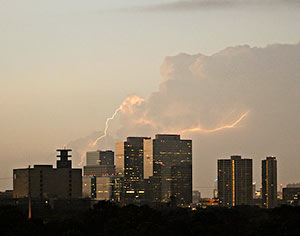 Last year Atlanta-based Cousins Properties splashed out big in the Houston office market, purchasing all 4.4 million sq.-ft. of Greenway Plaza for $950m in October, 8 months after they snapped up the $233m Post Oak Central complex, making Houston the dominant market in the CUZ portfolio. Which might have seemed a great idea in October 2013, when crude was going for about $100 a barrel, but now? A security analyst from Bank of America and Stifel have both downgraded Cousins Properties shares from “buy” to “hold,” citing falling oil prices and the company’s exposure to Houston. [Realty News Report] Photo of lightning over Greenway Plaza: Russell Hancock via Swamplot Flickr Pool
Last year Atlanta-based Cousins Properties splashed out big in the Houston office market, purchasing all 4.4 million sq.-ft. of Greenway Plaza for $950m in October, 8 months after they snapped up the $233m Post Oak Central complex, making Houston the dominant market in the CUZ portfolio. Which might have seemed a great idea in October 2013, when crude was going for about $100 a barrel, but now? A security analyst from Bank of America and Stifel have both downgraded Cousins Properties shares from “buy” to “hold,” citing falling oil prices and the company’s exposure to Houston. [Realty News Report] Photo of lightning over Greenway Plaza: Russell Hancock via Swamplot Flickr Pool
COMMENT OF THE DAY: WHY THE WATER IN YOUR NATURALLY FILTERED BAYOU-SIDE SWIMMING HOLE IS GOING TO BE BROWN  “I’ll bite. Here’s a very simple engineering analysis.
Problems with stream-fed swimming pools in Houston are going to be three-fold:
1) Silt (in engineer-speak, Total-Suspended-Solids or TSS). TSS is treated with sedimentation basins. That can be a large pool (that people don’t swim in) adjacent to the real pool. In water/wastewater treatment plants, a coagulant like alum is usually added to sedimentation basins to make TSS precipitate out quicker. If you’re going to do this with no chemicals, you’ve got to be willing to accept either VERY long treatment times, or only partially successful results. The tiny diameter of the clay particles that make up the TSS in our bayous just flat out won’t come out of suspension without a coagulant, so the water WILL be brown. It’s not necessarily a deal breaker — the water in Galveston’s brown too.
2) Bacteria (in engineer-speak, total coliform count). See here. Usually these are E. Coli, algae, and some protests. ALL streams/lakes/oceans in the entire world have this, even the cleanest and clearest. Realistically, to get an insurance policy to operate, the water’s going to have to be disinfected to some degree. That means chlorination (chemicals), ozonation (chemicals), or UV disinfection. More on UV in a minute.
3) Dissolved oxygen content. You don’t want the water to turn anaerobic. If there’s enough carbon-containing compounds dissolved in the water, the bacteria naturally in the water will eat it rapidly, causing the bacteria to use up all the oxygen that’s already dissolved in the water. This leads to any/all fish in the water suddenly dying off, as well as noxious smells and other really terrible stuff. You can make sure the dissolved oxygen doesn’t drop by filtering out carbon containing compounds (takes chemicals), or using aerators. A dual-way to solve the #2 and #3 issues is by passing the water over a very shallow (less than 6-in. deep) bed of rocks at a fast speed. Think rapids. This lets the water simultaneously re-oxygenate and also absorb huge amounts of UV. This might be the sort of silver bullet that makes this possible in Houston.
So: This is going to be expensive, but it’s probably do-able. However, the water is still going to be brown. Sorry.” [Ornlu, commenting on Bayou Swimming Hole Promoters Jump To Kickstarter To Jumpstart Project] Illustration: Houston Needs a Swimming Hole
“I’ll bite. Here’s a very simple engineering analysis.
Problems with stream-fed swimming pools in Houston are going to be three-fold:
1) Silt (in engineer-speak, Total-Suspended-Solids or TSS). TSS is treated with sedimentation basins. That can be a large pool (that people don’t swim in) adjacent to the real pool. In water/wastewater treatment plants, a coagulant like alum is usually added to sedimentation basins to make TSS precipitate out quicker. If you’re going to do this with no chemicals, you’ve got to be willing to accept either VERY long treatment times, or only partially successful results. The tiny diameter of the clay particles that make up the TSS in our bayous just flat out won’t come out of suspension without a coagulant, so the water WILL be brown. It’s not necessarily a deal breaker — the water in Galveston’s brown too.
2) Bacteria (in engineer-speak, total coliform count). See here. Usually these are E. Coli, algae, and some protests. ALL streams/lakes/oceans in the entire world have this, even the cleanest and clearest. Realistically, to get an insurance policy to operate, the water’s going to have to be disinfected to some degree. That means chlorination (chemicals), ozonation (chemicals), or UV disinfection. More on UV in a minute.
3) Dissolved oxygen content. You don’t want the water to turn anaerobic. If there’s enough carbon-containing compounds dissolved in the water, the bacteria naturally in the water will eat it rapidly, causing the bacteria to use up all the oxygen that’s already dissolved in the water. This leads to any/all fish in the water suddenly dying off, as well as noxious smells and other really terrible stuff. You can make sure the dissolved oxygen doesn’t drop by filtering out carbon containing compounds (takes chemicals), or using aerators. A dual-way to solve the #2 and #3 issues is by passing the water over a very shallow (less than 6-in. deep) bed of rocks at a fast speed. Think rapids. This lets the water simultaneously re-oxygenate and also absorb huge amounts of UV. This might be the sort of silver bullet that makes this possible in Houston.
So: This is going to be expensive, but it’s probably do-able. However, the water is still going to be brown. Sorry.” [Ornlu, commenting on Bayou Swimming Hole Promoters Jump To Kickstarter To Jumpstart Project] Illustration: Houston Needs a Swimming Hole

